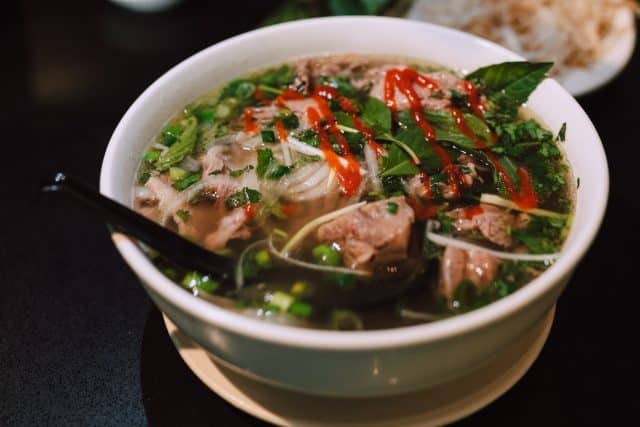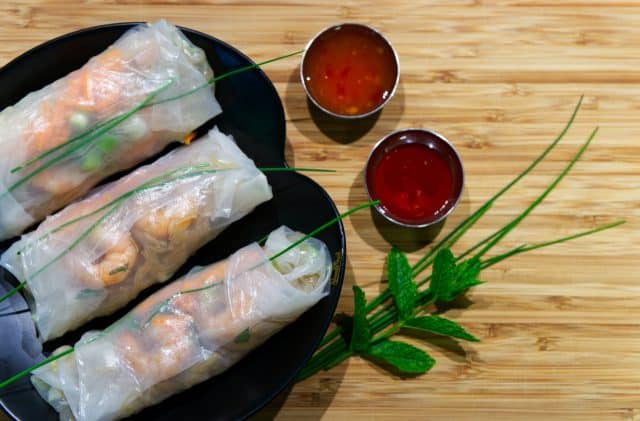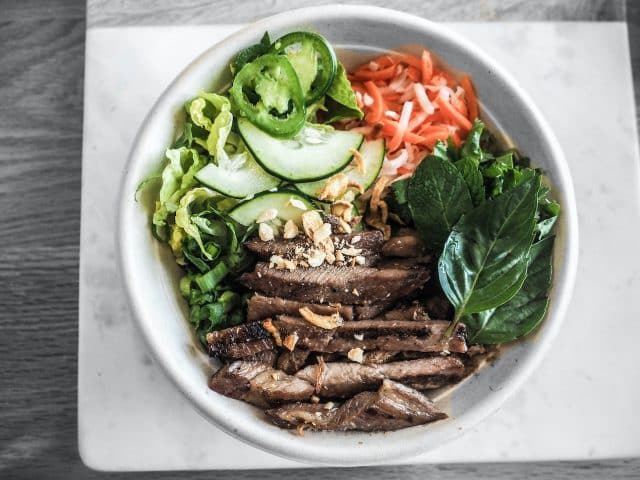Vietnam is a country with a rich and diverse culinary history. While the cuisine of the North, Central and South regions of Vietnam share some similarities, they also have their own unique flavors and ingredients. In this article, we’ll take a look at some of the most popular dishes from each region of Vietnam.

photo: Min An
The cuisine of Vietnam is as varied as the country’s landscape. From the mountains of the north to the rice paddies of the south, each region of Vietnam has its own unique style of cooking that reflects the local ingredients and flavors. In this article, we’ll take a look at some of the most popular dishes from each region of Vietnam.
The North of Vietnam is not just about the tropical rainforest, but also a region full with fresh fruit and vegetables. The most popular dishes here include pho (a noodle soup made from beef or chicken), banh mi sandwiches filled pickled vegetables inside grilled meatloaf-like cigarettes that you can get as filling for two dollars American cents at any street corner shop called “bun DT” ; nem ran fried spring rolls served warm in their own bamboo baskets along side dipping sauce so delicious it’ll make your mouth water even more than before!

photo: RODNAE Productions
The people of Central Vietnam have a distinctive menu that includes spicy food and seafood. Bun bo hue, or “spicy beef soup,” is one dish from this region known for its intense flavor as it contains peppers to bring out the inherent taste in meat dishes like pork or chicken noodle soups. Another popular item on their list would be banh xeo – flat noodles mixed with shrimp paste served cold during summer months when you can’t tolerate any heat! Finally there’s goi cuon: fresh spring rolls made using rice paper wrapping around vegetables such at cucumbers then filled up inside before being wrapped into little balls which look appetizing enough even without sauce.

photo: Alexander Sinn
The South of Vietnam is the country’s rice-growing region, and as such, many of the popular dishes from this region are made with rice. The most popular dishes from the south include com tam (broken rice with grilled meat), mi quang (a noodle soup made with shrimp, pork, and vegetables), and banh khot (a savory pancake made with shrimp and pork).

photo: Jer Chung
Discover must-visit destinations in Vietnam through our extensive Vietnam travel resources.
Vietnam is a country with a rich and diverse culinary history, and the cuisine of each region reflects the local ingredients and flavors. In this article, we’ve taken a look at some of the most popular dishes from each region of Vietnam. Whether you’re in the North, Central or South regions of Vietnam, you’ll find no shortage of delicious Vietnamese food to enjoy!

Isn’t it cool how Vietnamese cuisine varies by region? In the North, pho and banh mi shine, while Central Vietnam spices it up with bun bo hue. Down South, fresh spring rolls steal the show. And let’s not forget those lovely herbs and flavors that make Vietnamese dishes pop!
Ever wondered about the fantastic mix of flavors in Vietnam’s cuisine from North to South? Dive into the rich culinary tapestry influenced by neighboring countries. Explore the French touch in the North, the Khmer and Chinese flair in the South, and the magic of fresh herbs and condiments that elevate every dish.
It’s fascinating to see how Vietnam’s cuisine varies across its regions, with each place offering a unique taste experience. From the aromatic pho and flavorful banh mi in the North to the spicy bun bo hue and crispy banh xeo in the Central region, there is so much to explore and indulge in. And let’s not forget the refreshing goi cuon in the South! Vietnam’s diverse cuisine truly showcases the country’s rich culinary heritage.
Vietnam’s cuisine is an inspiring reflection of its rich culinary heritage. And you’re spot on, the goi cuon in the South is a revitalizing delight! It’s remarkable how each region offers a distinct taste experience, showcasing the diversity of Vietnamese cuisine. Have you had the opportunity to try dishes from all three regions yet?
Vietnam’s cuisine offers a delightful array of flavors and dishes that showcase the country’s rich culinary heritage, from the subtle and lighter influences of China in the North to the spicier and more vibrant flavors of neighboring countries in the South, making it a gastronomic adventure worth exploring.
culinary experience that is sure to delight any food lover with its unique blend of flavors and regional specialties.
Vietnamese cuisine is a true reflection of the country’s rich history and diverse geography. The different tastes of North, Central and South Vietnam are a testament to the unique culinary traditions that have been passed down through generations. If you’re a food enthusiast, I highly recommend trying out some of the popular dishes mentioned in the article, such as pho, bun bo Hue, and banh xeo, to get a true taste of Vietnam.
and unique experience that offers something for everyone, no matter their taste preferences. Whether you prefer mild and subtle flavors or bold and spicy dishes, there is sure to be a Vietnamese dish that will tantalize your taste buds and leave you wanting more. From the north to the south, every region of Vietnam offers its own culinary delights that are sure to satisfy even the most discerning palate.
@DalatDreamer As a food lover, I find Vietnamese cuisine to be an exciting and diverse culinary journey that is full of vibrant flavors and unique ingredients. I particularly enjoy the sweet and sour flavors of the central region’s dishes, and the bold and spicy flavors of the south. If you’re planning a trip to Vietnam, I highly recommend trying as many different dishes as you can to truly experience the country’s rich and diverse culinary culture.
Interesting idea! Trying different dishes in Vietnam is a must to fully experience their diverse cuisine. Any particular dish you suggest?
Vietnamese cuisine is a true representation of the country’s rich culture and history. From the North’s simple yet delicious pho to the South’s sweet and spicy banh xeo, each region offers a unique culinary experience. Interestingly, Vietnam is home to over 500 traditional dishes, making it a food lover’s paradise.
I love trying new food when I travel and Vietnam did not disappoint. I was able to try so many different dishes from all over the country and each one was so unique and delicious. I definitely gained a few pounds while I was there, but it was worth it!
Different regions have their own unique flavors in Vietnamese cuisine.
I think the north central region has a better style of cuisine. The south has a lot of flavors, but they’re all kind of bland.
@FFF1
I’m so glad to hear that you’ve had the opportunity to experience the different tastes of Vietnam! I find the cuisine from the North to be particularly unique and flavorful. The Central region also has some amazing dishes that I’m sure you’ll love.
Interesting topic. I’ve never been to Vietnam, but I’ve always wanted to check out their cuisine. I’m guessing that the flavors in the north central and south would be different since they’re located in different parts of the country.
@DeLaCruz
What are some of the signature dishes from each region?
You’re in for a delightful treat when it comes to the diverse tastes of Vietnam! In the North, dishes like pho and bun cha will have you happily slurping noodles and relishing grilled pork. Speaking of pork, the Central region offers scrumptious dishes like banh xeo and mi Quang. But wait, let’s not forget about the South! Their banh mi and com tam will leave you longing for more. So, whether you’re exploring the North, Central, or South, there’s an abundance of mouthwatering flavors to discover. Enjoy your culinary adventure!
I’m excited to try out some of the different flavors of Vietnam cuisine! This post has a great variety of information.
@TheDunns7 The way that Vietnamese cuisine varies so much from region to region is fascinating, and I can’t wait to explore the unique tastes of each area.
I prefer central food the most. I think in some cases the tastes and quality are very simular but they have different ways of utilizing what they have.
A lot of this likely comes down to the weather. Different areas grow different crops at different times. I love that you can get so much diversity in terms of food dishes going to different areas!
The northern cuisine is known for its simplicity and fresh ingredients, while the southern cuisine is more complex, uses more spices and herbs.
I think the biggest thing to remember is that when it comes to food, cultural differences can be very subtle. In Vietnam, for example, there’s a huge difference between the food in the North Central and South regions of Vietnam. But it’s not like you’ll be able to tell just by looking at a plate of food, you might not even taste it!
I’ve been lucky enough to travel all over Vietnam, and I can tell you that some of my favorite meals were from places where people from other regions would say “this isn’t real Vietnamese food.” And I’m sure they’re right but that doesn’t mean they weren’t delicious!
@Habanero I’ve always been fascinated by the diversity of Vietnamese cuisine, especially how the same dish can taste so different depending on where you are in the country. It’s amazing how a small change in ingredients or cooking method can completely transform a dish!
It’s true that appearances can be deceiving when it comes to food. Understanding various cultural nuances enhances our culinary experiences.
I love how this article talks about the different tastes of Vietnamese food, and it’s clear the author knows their stuff.
I’m planning a trip to Vietnam, and I’m excited to try all kinds of new foods.
I don’t know if I ever actually noticed this before when I was spending time in Vietnam. It makes sense though that different areas would offer different tastes. This is pretty cool though learning about it. Now I know where to go to get the best of any type of dish.
I prefer food down in the south. They do have a lot of rice dishes and I love rice. They also seem to have more variety that is not loaded with spice. I like some things hot but not everything.